null
Why do plants need a transport system?
large req transport system to effectively transport oxygen and glucose were needed for respiration
small surface area to volume ratio, so diffusion alone is too slow for their needs.
high metabolic demands, especially in areas like growing shoots and roots.
need to transport water and minerals from roots to leaves and assimilates (like sugars) from leaves to the rest of the plant.
Draw the structure of the transport system in roots and describe its function
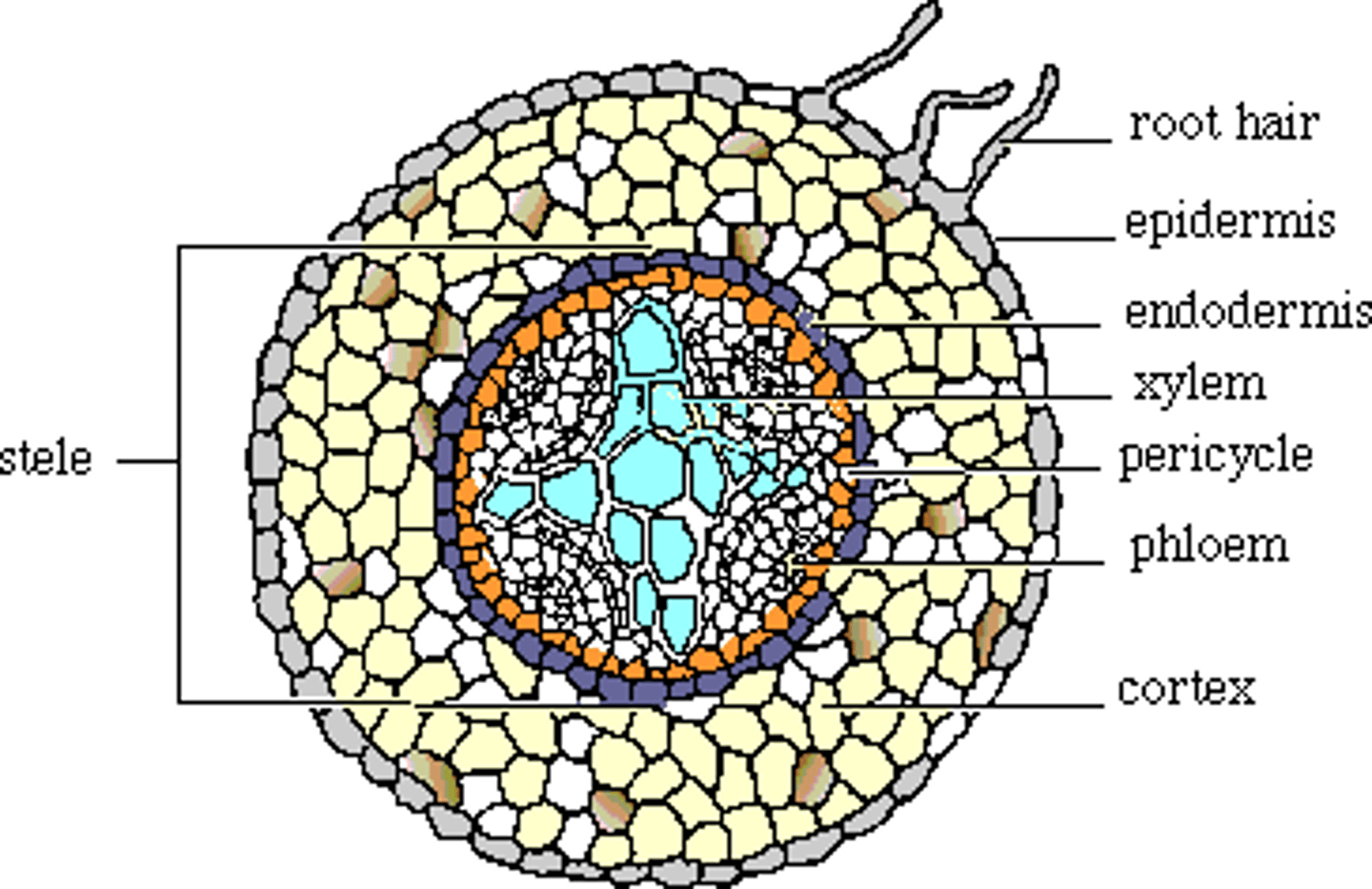
Epidermis: outer layer; protection and water absorption
Cortex: storage and water movement
Endodermis: contains Casparian strip to regulate water entry
Xylem: transports water and mineral ions
Phloem: transports assimilates
endodermis-epidermis-exodermis
help the plant withstand tugging due to the stem and leaves being blown by the wind.
1/45
There's no tags or description
Looks like no tags are added yet.
Name | Mastery | Learn | Test | Matching | Spaced |
|---|
No study sessions yet.
46 Terms
Why do plants need a transport system?
large req transport system to effectively transport oxygen and glucose were needed for respiration
small surface area to volume ratio, so diffusion alone is too slow for their needs.
high metabolic demands, especially in areas like growing shoots and roots.
need to transport water and minerals from roots to leaves and assimilates (like sugars) from leaves to the rest of the plant.
Draw the structure of the transport system in roots and describe its function
Epidermis: outer layer; protection and water absorption
Cortex: storage and water movement
Endodermis: contains Casparian strip to regulate water entry
Xylem: transports water and mineral ions
Phloem: transports assimilates
endodermis-epidermis-exodermis
help the plant withstand tugging due to the stem and leaves being blown by the wind.

Draw the structure of the transport system in the stem and describe its function
Epidermis: outer layer; protection
Xylem and phloem: arranged in vascular bundles around the stem for support and transport
provides strength and support
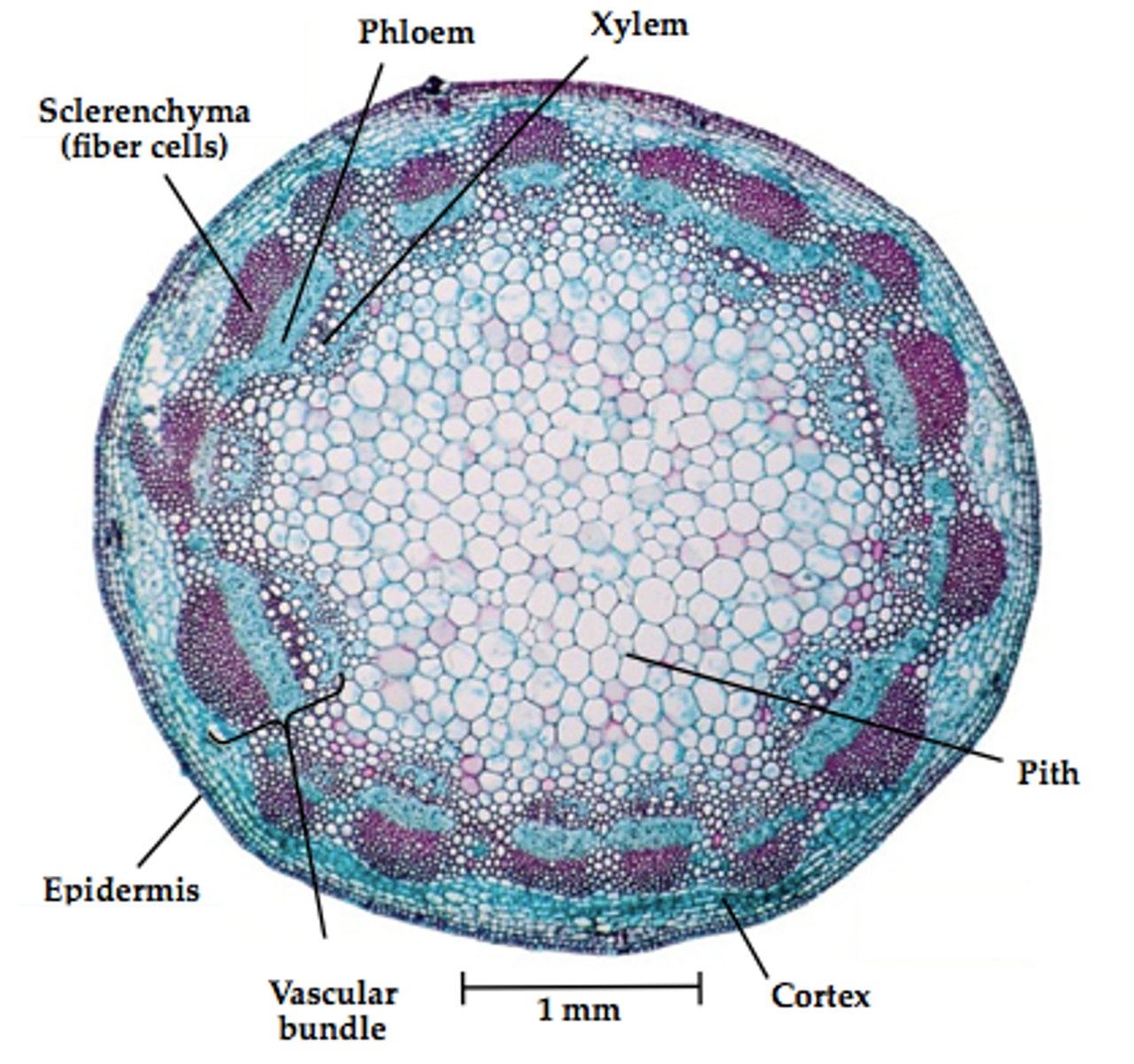
Draw the structure of the transport system in the leaves and describe its function
Midrib: main vein, supports leaf and contains xylem and phloem
Vein network: branches off midrib, distributing water and sugars
Function: Transport of water to mesophyll and sugars from photosynthesis; structural support.
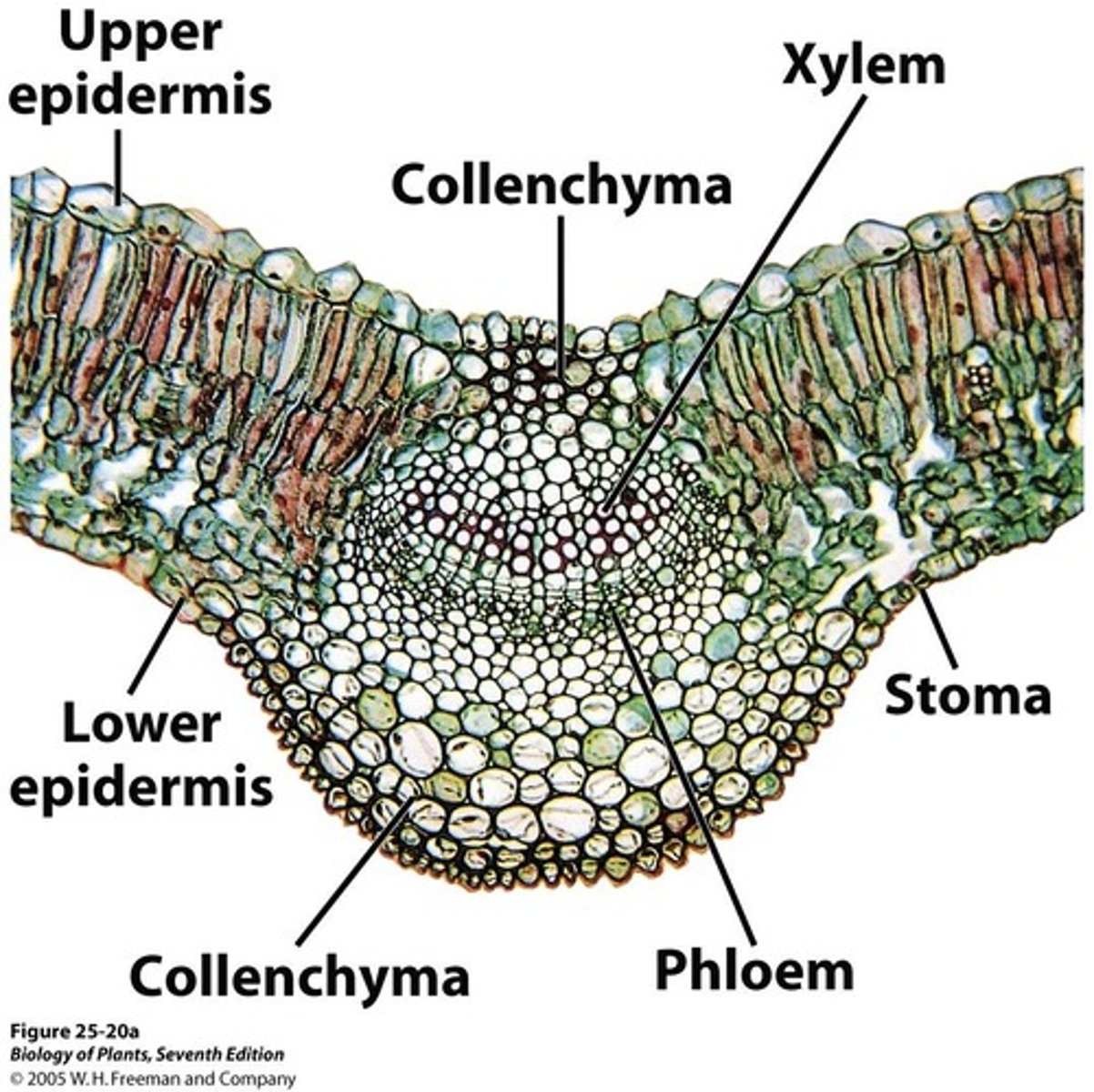
What is the function of the xylem
Transports water and mineral ions from roots to leaves
Provides structural support due to lignified walls
What is the function of the phloem
To transport amino acids and sucrose in sol from the source to sink via translocation
Describe the structure and function of the xylem?
Made of dead cells fused end to end to form long,
hollow vessels and no nucleus
Lignin in walls for strength; can be in spirals/rings
Bordered pits (small unlignified area) allow sideways water movement
Surrounded by parenchyma for storage and tannin (bitter to herbivores)
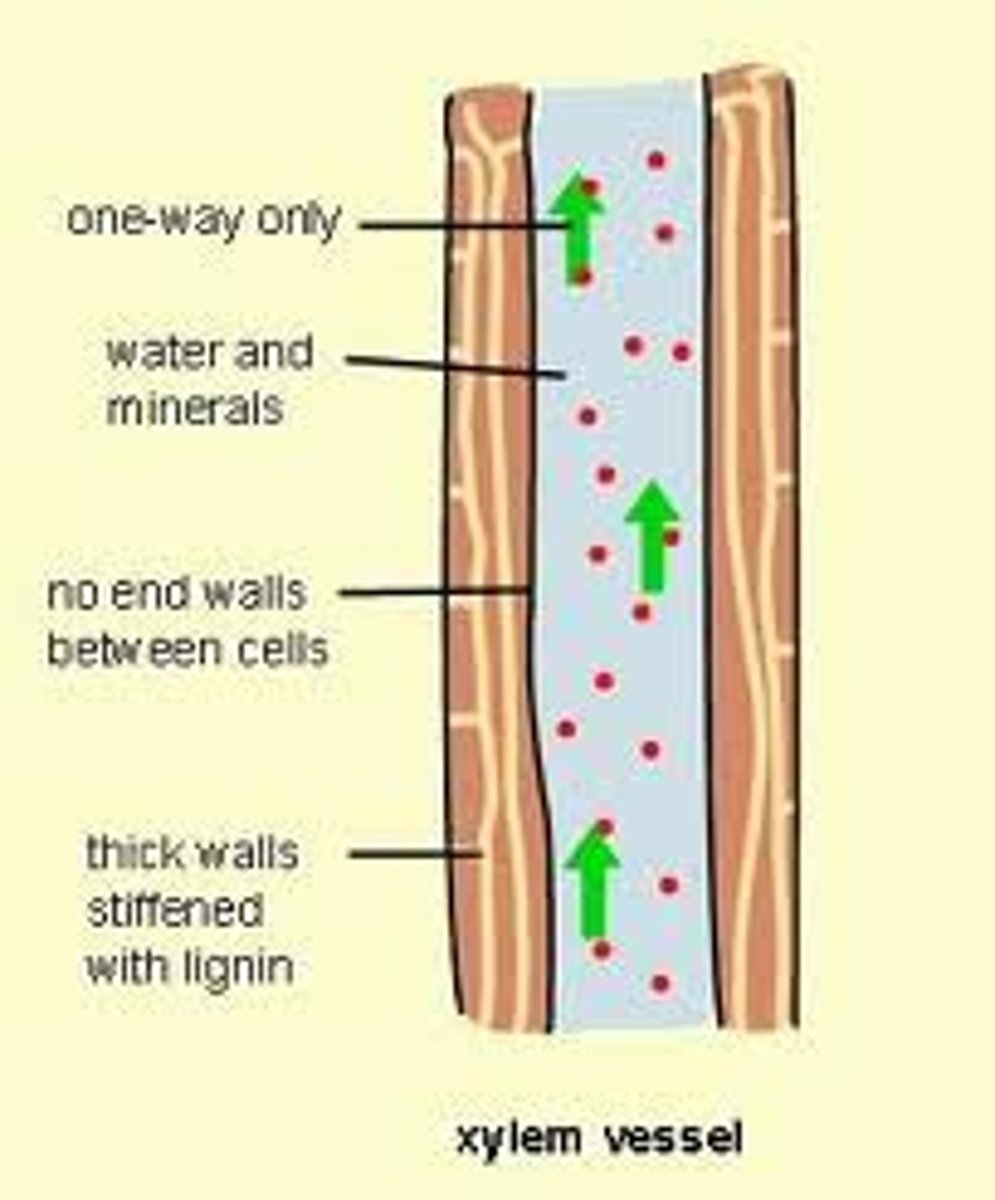
Describe the structure of the phloem and describe its function
Made of living cells, but sieve tube elements have no nucleus
Sieve plates: perforated end walls for flow
Linked close to companion cells: have many mitochondria and nuclei to support sieve tubes
Filled with phloem sap
What are companion cells?
Cells that closely linked to sieve tube elements
Large nucleus and dense cytoplasm
Packed with mitochondria for ATP production
Carry out metabolic processes and active loading of sucrose
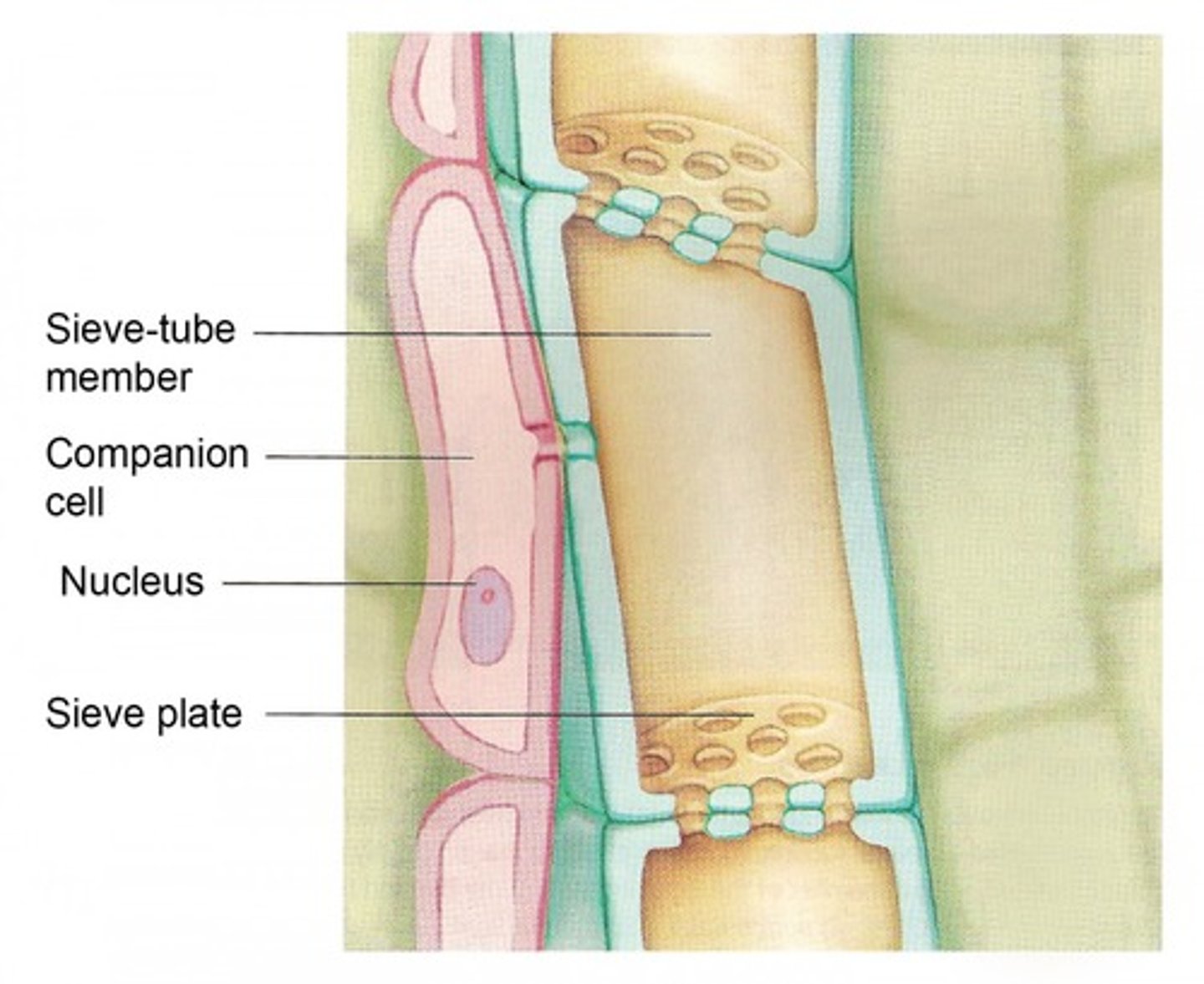
Importance of water in plants?
Turgor pressure as a result of osmosis provides a hydro skeleton to support the stems and leaves
turgor also drives cell expansion such as roots forcing their way through concrete
the loss of water thorough evaporation cool the plant down
mineral ions and sucrose are transported in aqueous solutions
How are roots well adapted as exchange surfaces?
They're microscopic so they can penetrate easily between soil particless
Each microscopic hair has a large surface area
Each hair has a thin surface layer/one cell thick to diffusion and osmosis is quicker
The concentration of solutes in the cytoplasm of root hair cell maintain a water potential gradient between the soil and the cell
What are the 3 different types of pathways water takes across the root?
Apoplast, Symplast and vacuolar
Explain the apoplast pathway
Water moves through cell walls and spaces between cells
Moves by cohesion (water sticking to water)
At the endodermis, the Casparian strip blocks the apoplast route, forcing water into the cytoplasm
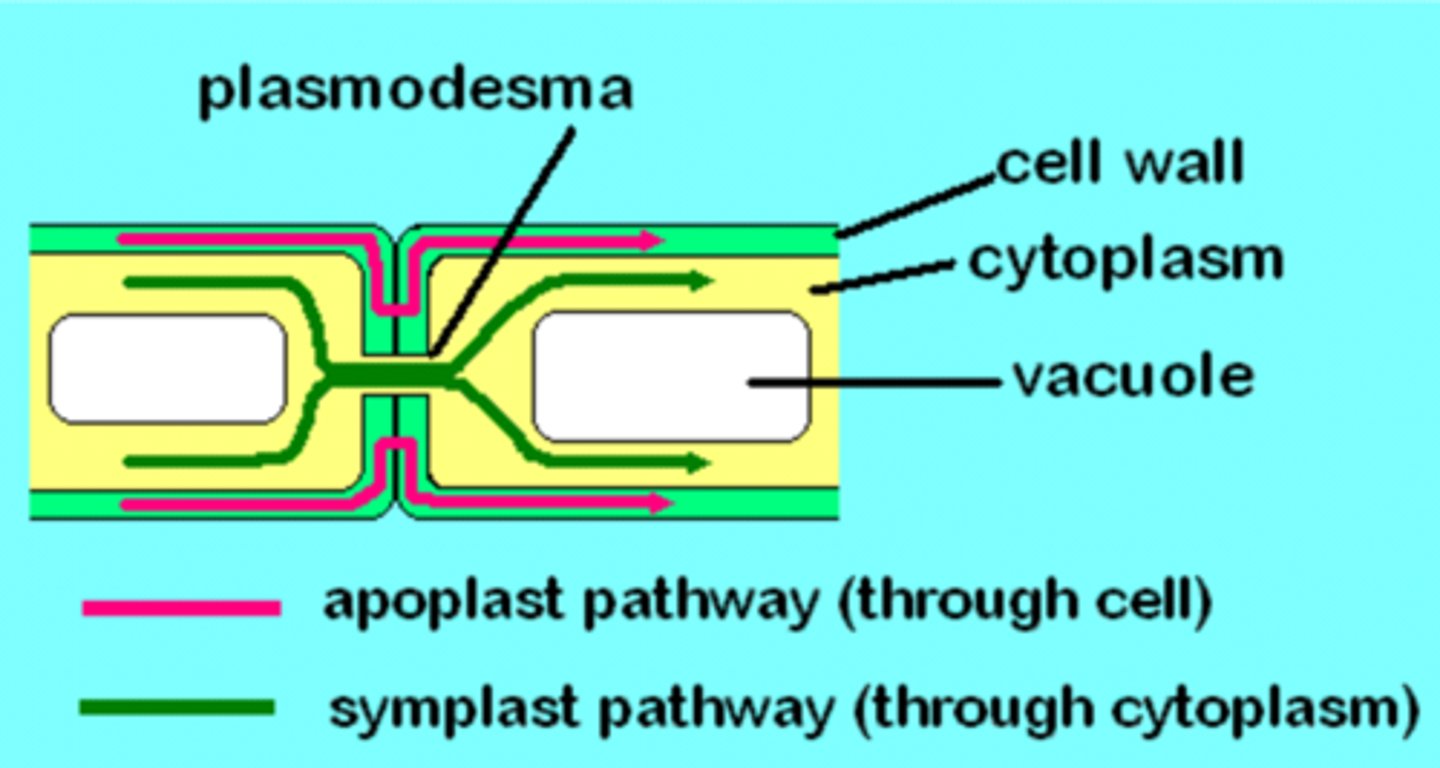
Explain the Symplast route
Water moves through the cell cytoplasm.
Then passes through plasmodesmata from one cell to the next by osmosis. continues pathway
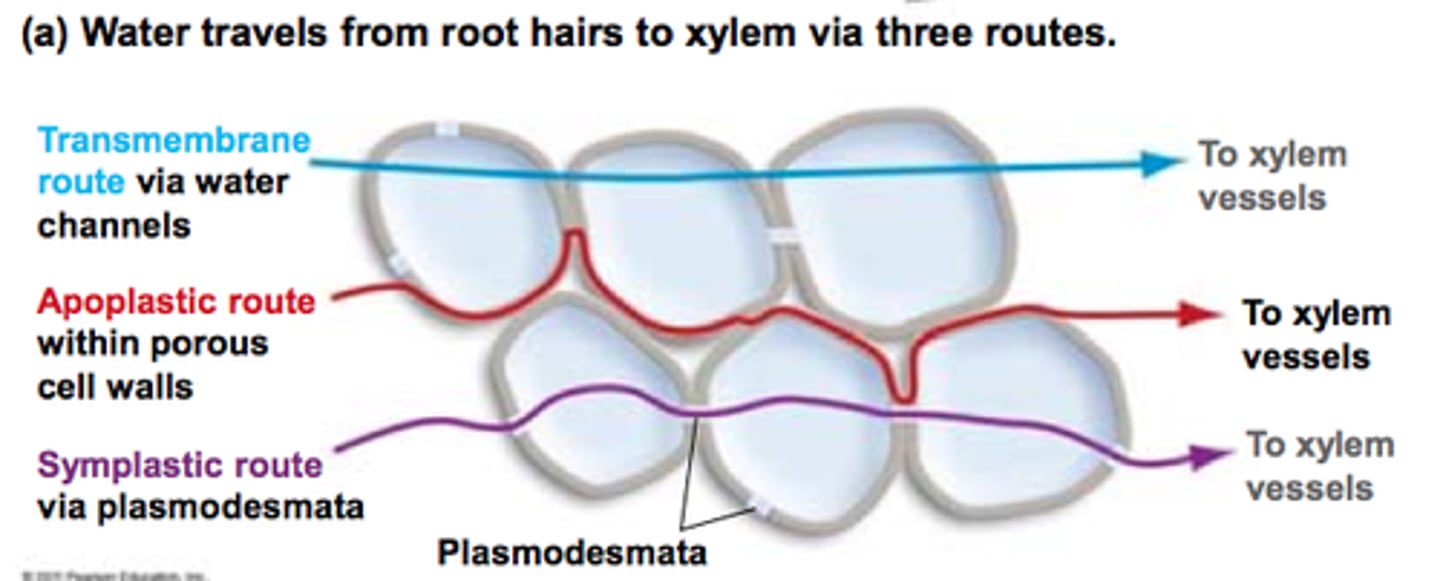
Explain the Vacuolar route ( extension question )
Water moves through vacuoles in addition to cytoplasm
Slower and less significant than apoplast/symplast routes
Describe the mechanisms of the movement of water from the root into the xylem?
-water potential
-adhesion
-cohesion
-transpiration stream
What is the casparian strip?
A band of waxy material called suberin that runs around each of the endodermal cells forming a waterproof layer
Explain the movement of water from the root into the xylem?
1)water moves into the root cells by osmosis
Water travels via apoplast and symplast pathways
2)the apoplast pathway is blocked by the Casparian strip and the water is forced to move in the symplast route in the cytoplasm
3)water moving into the cytoplasm passes through a selectively permeable membrane therefore toxins are removed
4)the ions are actively transported from the endodermal cells to the xylem, this lowers the water potential and water can move into the xylem by osmosis through the symplast route this is known as root pressure
5)once in the vascular bundle water moves back into the apoplast route and moves up the xylem
What is root pressure? ( extension question )
the active pumping of ions/minerals into the xylem from the endodermal cells to produce the movement of water by osmosis, giving water a little push up the xylem but is not the major factor
What is the evidence of active transport in root pressure? ( extension question )
Cyanide inhibits root pressure (ATP needed)
Root pressure increases with temperature suggests its a chemical reaction
Root pressure falls with low oxygen, O2 needed for synthesis of ATP
Xylem sap exudes when stem is cut
What is transpiration?
Loss of water vapour through stomata
Water evaporates from mesophyll cells and diffuses out
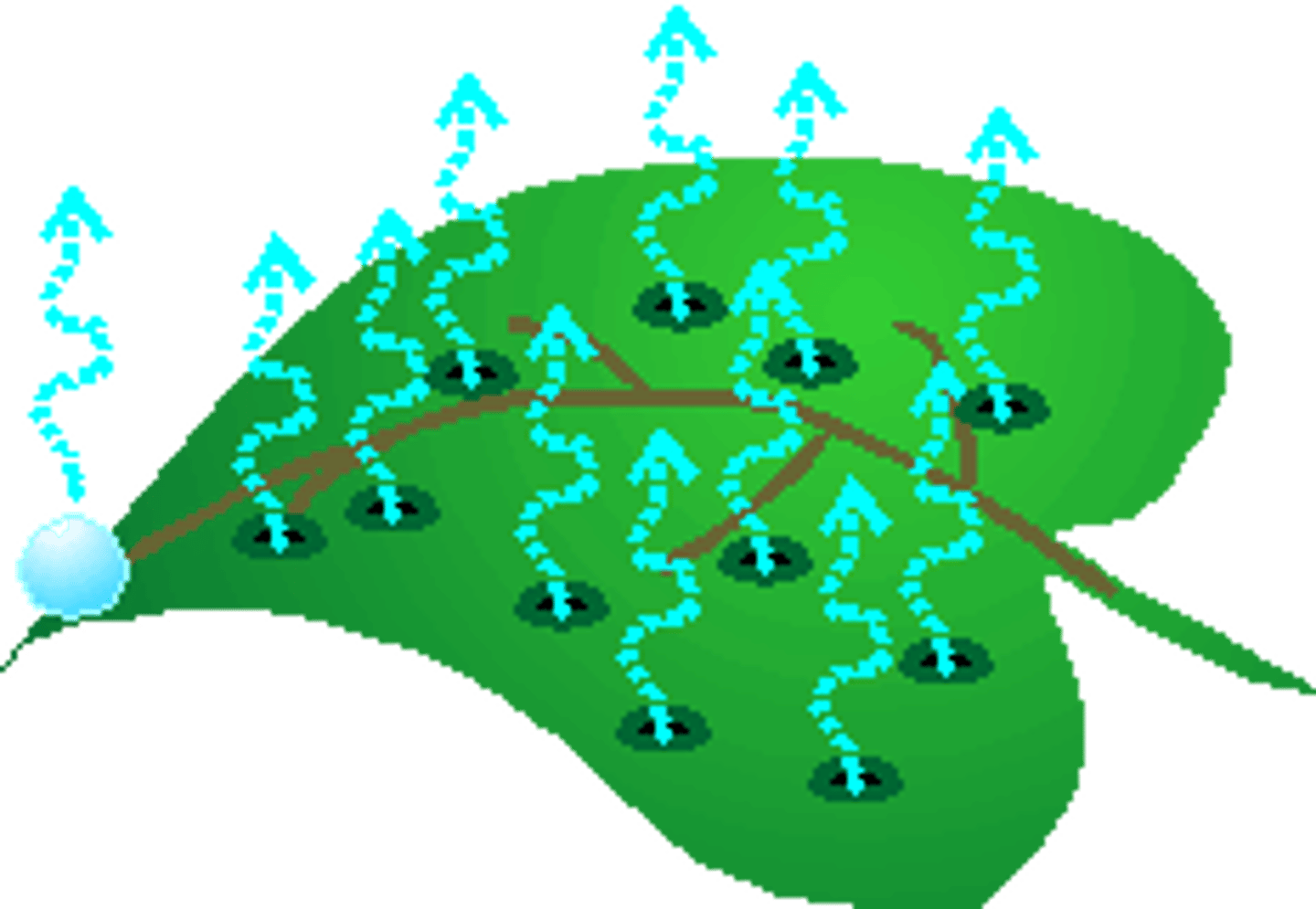
What i the process of transpiration ?
When stomata open for gas exchange, water vapour moves by diffusion and is lost
What is the transpiration stream?
“Continuous movement of water from roots to leaves as response to transpiration”
Evaporation from mesophyll cells into the air spaces in the leaf
water vapour moves out of the stomata by diffusion known as transpiration creating a low water potential in the mesophyll cells
Water drawn from adjacent cells by osmosis
Water pulled up via xylem
What is adhesion and cohesion?
Cohesion: water molecules stick to each other via hydrogen bonds
Adhesion: water molecules stick to xylem walls
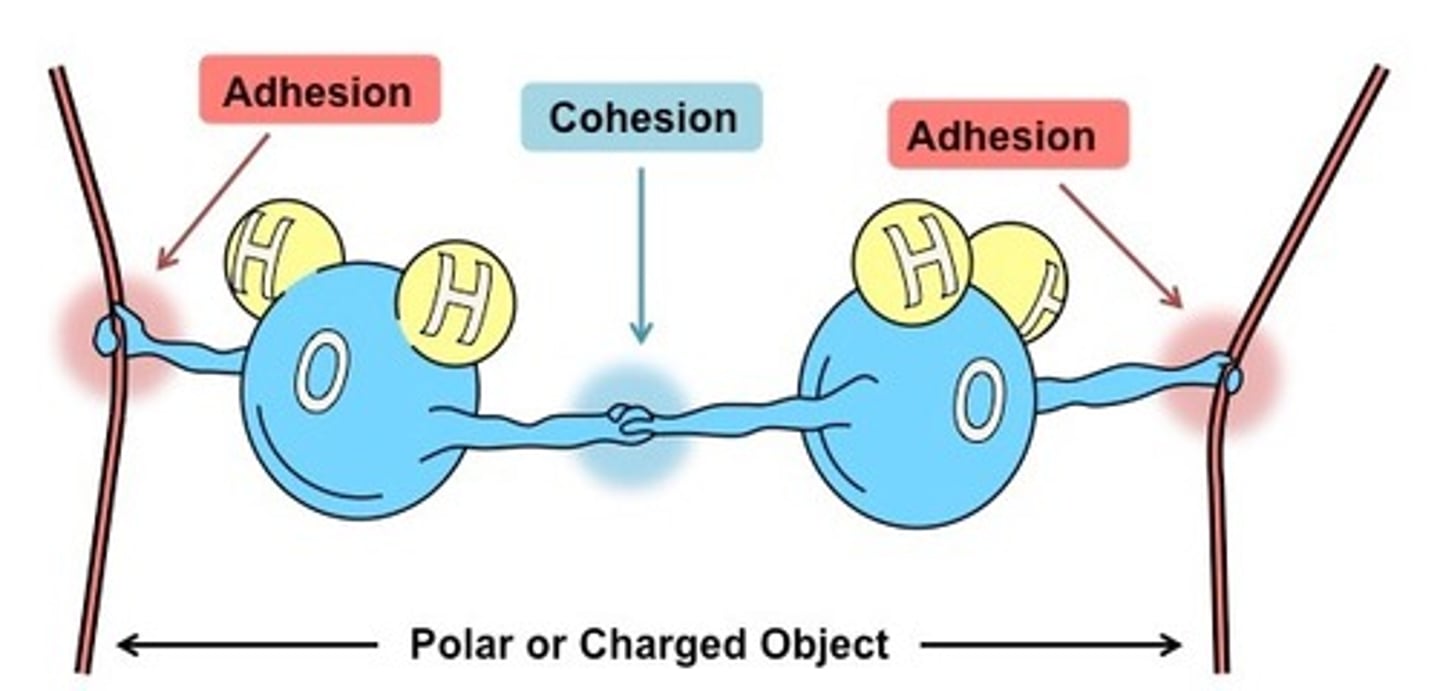
What is capillary action?
the result of cohesion and adhesion which allows water to rise up a narrow tube against the force of gravity.
What is transpiration pull?
Is the force that drives transpiration stream caused by the adhesive and cohesive forces of water molecules
What is capillary action?
This is the process by which water can rise up and narrow tube against the force of gravity due to the adhesive and cohesive forces between water.
Why is transpiration important?
1)water vapour lost must be replaced from below, drawing water up from the transpiration stream.
2) The movement of water transports useful mineral ions and products of photosynthesis
3)water evaporates it keeps the plant cool on a hot day
4)provides a hydrostatic skeleton to support the stem and leaves as a result of turgor pressure from osmosis
What is the cohesion-tension theory?
Water forms a continuous
column in the xylem because of the cohesive forces between water molecules
Tension created by transpiration pull
Maintained by cohesion between water molecules
What is the evidence for the cohesion-tension theory?
Changes in the diameter of a tree during the day where the transpiration rate is increased, the diameter is decreased.
When a xylem vessel is broken, air is drawn in and no water leaks out, showing that the cohesive forces of water are broken.
How does the stomata control the rate of transpiration?
when conditions are favourable the guard cell actively pumps potassium allowing water to move in by osmosis so the cell wall becomes turgid (opened)
guard cell actively pumps potassium out of the cell water moves out by osmosis so the cell becomes flaccid (closed)
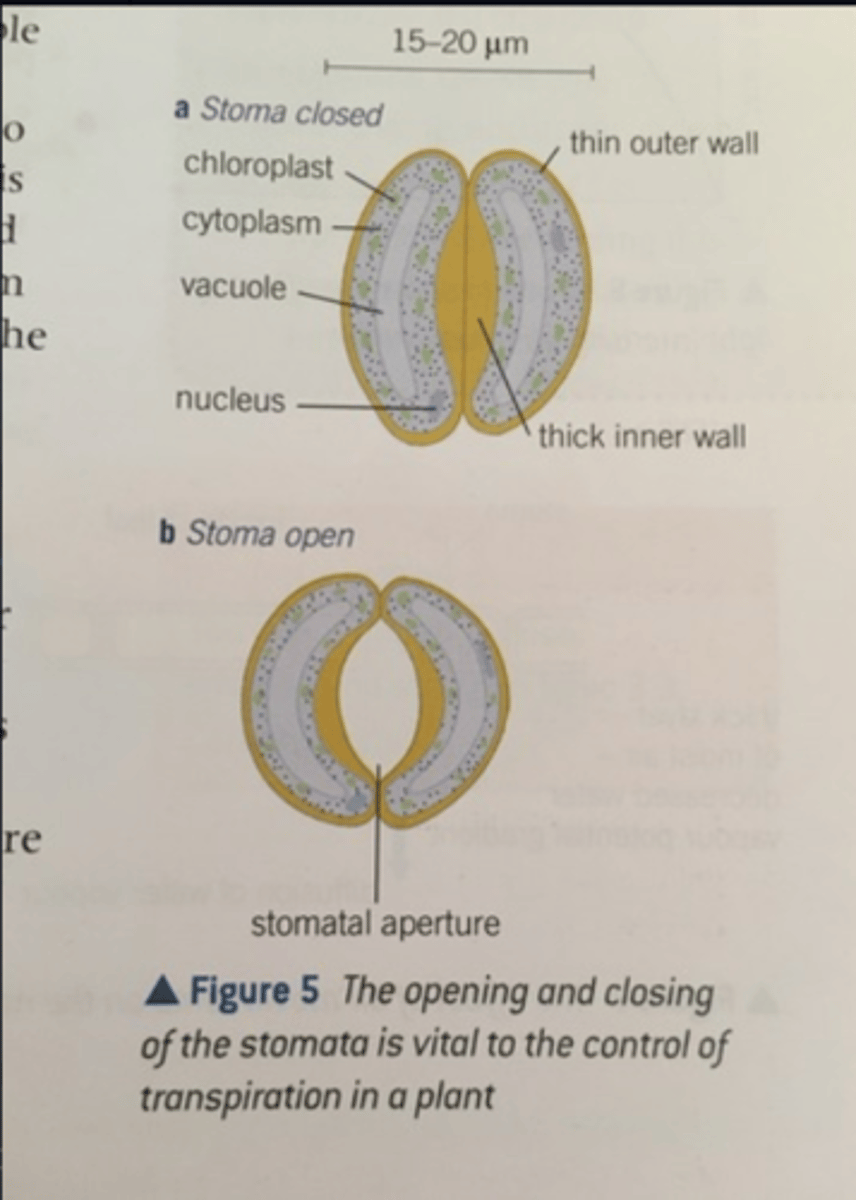
Why is transpiration unavoidable?
Because the stomata must open to exchange oxygen and carbon dioxide, and water vapour is lost in the process.
What are the factors affecting transpiration?
Light intensity- In light, stomata open allowing gaseous exchange for photosynthesis, increasing the rate of transpiration.
Temperature- In higher temperatures, evaporation and diffusion are faster, increasing the rate of transpiration.
Humidity- This decreases the rate of transpiration, the the concentration of water is higher outside the plant than inside.
Wind- carries water away so maintains high water vapour potential, increasing the rate of water loss and transpiration.
Water availability- little water in the soil means the plant can't replace water loss, stomata close and leaves wilt
Number of larger surfaces faster rate of uptake of water stomata
Size of leaves- bigger leaves have larger SA: V and more stomata=faster rate of transpiration
What is a potometer?
A piece of equipment used to estimate transpiration rates, by measuring the amount of water taken up by the plant.
What are the assumptions when using a potometer
It assumes all uptake is lost (but some might be used for photosynthesis/respiration/turgid).
Also uptake by a detached shoot may not be same as the whole plant.
How is a potometer used?
1. Cut shoot underwater to prevent air from entering the xylem, also cut at an angle to increase SA for uptake
2. Assemble equipment underwater and insert shoot underwater to prevent air from entering
3..Dry leaves
4. Remove the capillary tube from the beaker until one bubble formed then put it back into the beaker
5. Record the starting position of the bubble
6. Start the stopwatch and record the distance moved per time unit. It should be measured every 3 minutes for 30 minutes.
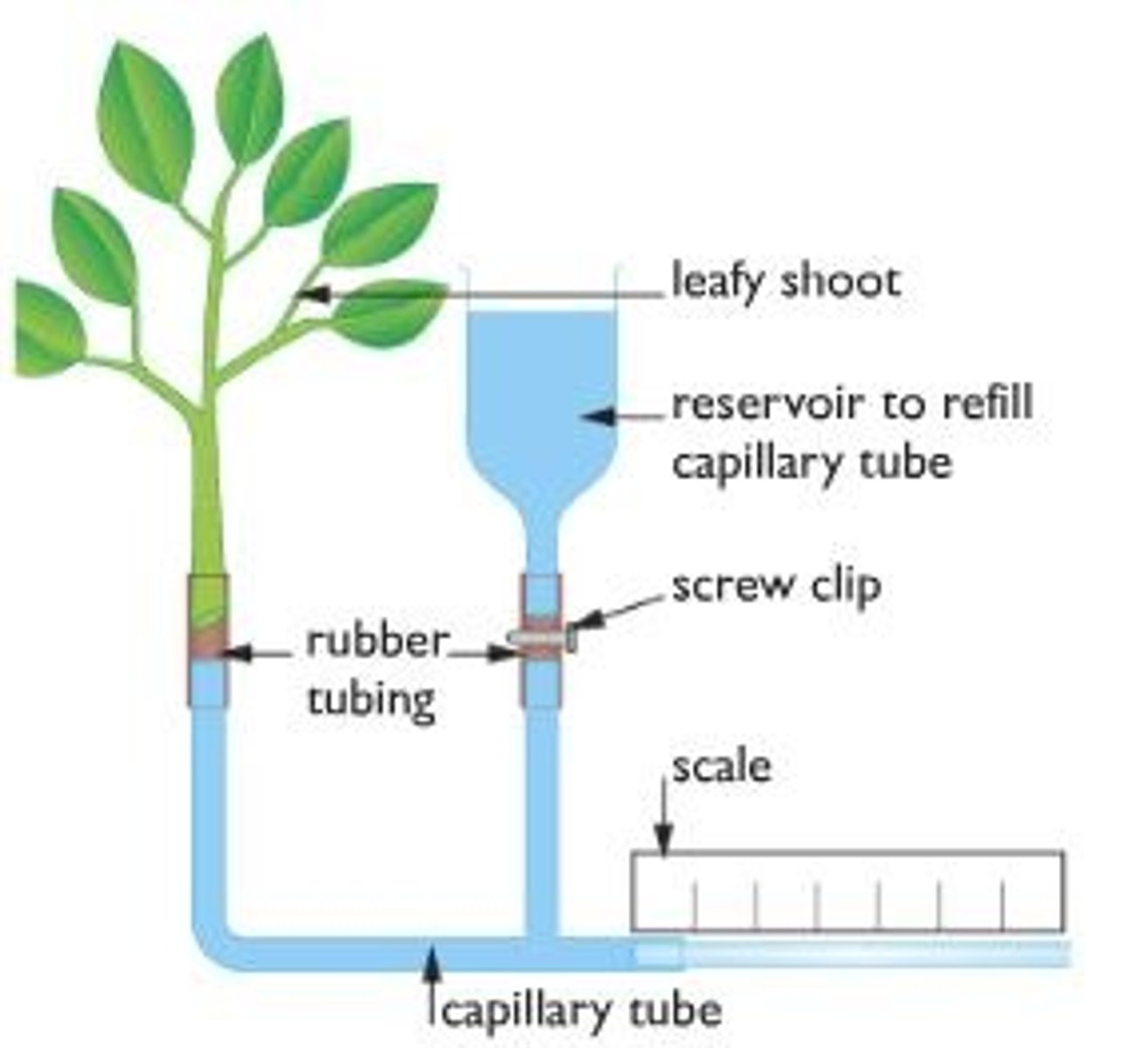
What is translocation?
Movement of soluble organic substances (assimilates such as sucrose and amino acids ) through the phloem from the source to the sink via mass flow
What is a sink?
Where assimilates are unloaded, used
E.g roots that are growing, developing organs and meristems that are actively dividing
What is a source?
Where assimilates are loaded, produced
E.g. green leaves and green stem, storage organs.
What is active loading and how does it occur?
Sucrose travel in the wall of companion cell and sieve elements via the apoplast route
Sucrose is loaded into a sieve tube using active loading.
ATP in companion cells. Energy is used to actively transport H+ ions (hydrogen pump) out of companion cells, increasing the concentration of H+ ions outside the cell and decreasing the concentration inside the companion cell.
H+ facilitated diffuses back into companion cells through special co-transporter proteins which only allow H+ back in if accompanied by sucrose.
As the concentration of sucrose in the companion cell increases it diffuses through plasmodesmata into the sieve tube element cell. Water moves in by osmosis
This generates turgor pressure and the assimilates in the water move by mass flow
How is sucrose moved in the phloem?
Moves via mass flow from high pressure (source) to low pressure (sink)
At the source: sucrose enters phloem, water follows, increasing pressure
At the sink: sucrose is removed, water exits, lowering pressure
Creates a pressure gradient for flow
What is the evidence of translocation?
Advances in microscopy shows adaptations of companion
cells for active transport
Mitochondria inhibitors (e.g. cyanide) stop translocation
Translocation is faster than diffusion
Aphid experiments show pressure differences and direction of flow
What is a xerophyte?
Plants adapted to arid/dry conditions
e.g marram grass and cacti
What are some xerophyte adaptations?
Thick Waxy cuticle- reduces water loss due to evaporation through epidermis cells on leaves
Sunken stomata/ Hair/ Curled leaves-create a microclimate of still humid air, lowering water vapour potential gradient and trapping the water vapour
Less stomata/less leaves/ leaf loss/ avoiding the problem (death)
Long shallow roots
Succulents-storing water in steams or leaves
Spongy mesophyll very dense- few air spaces meaning less surface for evaporation of water
Small leaves-reduce SA:V, reducing rate of transpiration
What is a hydrophyte?
Plants adapted to living fully submerged in water
E.g. water lilies
Adaptations of hydrophytes
Very thin or no waxy cuticle
lots of stomata, stomata always open
reduced structure
wide flat leaves
small roots
large surface area of stems and roots under the water